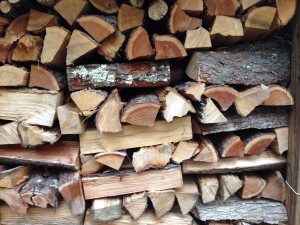warmth
Before the snows set in and the historic houses in our region close for the long winter nights, we have been trying to visit as many of these structures as possible in western Massachusetts. At the same time, we are preparing for our long winter’s nights, by completing fall chores that include putting the gardens to bed, making applesauce and apple butter, and most importantly, stockpiling wood to keep the house warm.
A few weeks ago, we headed out to Historic Deerfield, a village filled with a variety of period buildings. As we stood in the main room of the Williams House, our guide directed our attention to the fireplace, and asked us if we knew why the fireplace opening was completely covered by a screen. While we thought it was to keep out drafts when the fireplace was not in use, in fact the screen was placed to keep out critters (birds, bats, the occasional raccoon). He then reported that this house took between 40-50 cords of wood to heat it in the winter. Did we hear him correctly, I wondered? Indeed: 40-50 cords. [A cord of wood: four feet high, eight feet long and four feet deep.]

We use 14-15 cords to heat our 1753 house and, granted, it has more modern insulation, better windows, and a new roof to boot. And our exterior wood furnace is much more efficient, but 50 cords! Egads! M primarily takes advantage of the modern tools of chain saw and log splitter (but still enjoys splitting many of the logs by hand with a maul, thus being warmed twice). Imagine how many hours of labor it took to accumulate 50 cords of wood—felling each tree, hitching it to a mule and dragging it, bucking it up (fireplace sized pieces), splitting the wood, and finally hauling it into the house. No wonder it was a sin to let the home fire burn out.
Our guide next directed our attention to brilliantly colored and stenciled floor cloth, explaining that these were much easier to clean, for they were made from canvas and painted with many layers of oil paint. He then asked us to imagine the street scene of yore—muddy and much dirtier. Jill Lepore gives us a sensory glimpse of this world, albeit she is describing colonial Boston. I suspect this describes any colonial street:
Pigs rutted in the streets; horses clattered on the cobbles; the blood of butchered chickens dripped to the floor. The house smelled of soap and tallow and leather and smoke, and it smelled, too, of sweat. Each cord of wood had to be ported and stacked. Every bucket of water had to be hauled from one of the city’s wells. Every pot of night soil had to be lugged out the door and dumped into the privy in the yard. Soap had to be boiled and linens scrubbed.
When we start up the wood furnace, I’ll again reflect on the challenges colonial families faced and imagine the women of this house huddled by the wood fire, appreciating its warmth.
Jill Lepore, Book of Ages: the Life and Opinions of Jane Franklin, (Alfred A. Knopf, 2013), pg. 66
NOTE: This Satuday, October 19th, there are many events at Historic Deerfield: Archaeology Day, including a tour with Dr. Robert Paynter; Stoneware with Mark Shapiro; Works on the Wheel with Stephen Wary; a lecture—The Pocumtuck Fort Site; Open Hearth Cooking; and From Nature to Color: Fun with Natural Dyes. Please see their website for full details: http://www.historic-deerfield.org
particularly sobering given the waste from the privy probably [eventually] soaked down through the earth to meld with the waters of the wells….